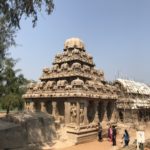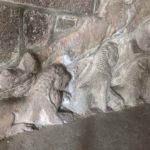Tala to Chennai – 1307 km (car and air)
& 20, 696 Ft Bit steps
We left Bandhavgarh (Tala) by car for Jabalpur to catch a flight to Chennai, from where we intended to tour southern India by train. Although we were closer to Darjeeling, we decided it made sense to go south and then stop in Darjeeling on our way to Bangkok.
Chennai (previously Madras) is another huge city, with a population of 10M, but with a cleaner, more welcoming vibe to it than Mumbai or Delhi. We had only intended to stay one night, but with difficulties finding accommodation further south during the busy tourist time of year, we decided to use Chennai as a base for a few days while we considered next steps.
After spending a day laundering the entire contents of our packs and getting haircuts, we hired a driver to take us to Mahabalipuram, on the coast south of Chennai. Before leaving the city, we stopped to visit the large and intricately adorned, rainbow colored 16th C Kapaleeshwarar Temple. This contrasted with the 1896 neo-Gothic Roman Catholic Cathedral of San Thome in the southern neighbourhood of Mylapore. There is evidence that the ancient port city of Mylapore traded with Greek, Roman and Chinese merchants. St. Thomas the apostle arrived here in AD52 and was killed 20 years later for his attempts at conversions.
As it was the Republic Day long weekend, there were crowds of people in Mahabalipuram, families dressed in their finest, spirting India flags. Many were dressed all in red, indicating they had made or were were making a pilgrimage to the nearby Mel Maruvathur Adiparasakthi Temple.
Mahabalipuram was the major seaport of the ancient Pallava dynasty. Built in the 7th C, the 400 monuments and temples of the town are UNESCO designated. The group contains several categories of monuments: ratha temples with monolithic processional chariots, built between 630 and 668; mandapa viharas (cave temples) with ancient Hindu narratives and inscriptions in a number of Indian languages and scripts; rock reliefs, stone-cut temples built between 695 and 722, and archaeological excavations dated to the 6th century and earlier. Almost all of them carved in situ from the granite bedrock, the temples and statues have survived remarkably intact. The Five Rathas, each carved from single large rocks, were buried in sand and uncovered 200 years ago.
Other monuments are carved into the rock of Mahabalipuram Hill. Arjuna’s Présence, a massive relief carving inscribed on two huge, adjacent boulders, contains scenes of Hindu mythology and everyday South Indian life. The Lonely Planet guide describes the scene “In the centre, nagas (snake beings ) descend a once water-filled cleft, representing the Ganges. To the left Arjuna (hero of the Mahabharata) performs self-mortification (fasting on one leg), so that the four-armed Shiva will grant him his most powerful weapon, the god-slaying Pasupata. Some scholars believe the carving actually shows the sage Bagiratha, who did severe penance to obtain Shiva’s help in bringing the Ganges to earth. Shiva is attended by dwarves, and celestial beings fly across the carving’s upper sections. Below Arjuna/Bagiratha is a temple to Vishnu (mythical an- cestor of the Pallava kings), with sages, deer and a lion. The many wonderfully carved animals include a herd of elephants and – humour amid the holy – a cat mimicking Arjuna’s penance to a crowd of mice”.
In the Krishna Mandapa is a carving of Krishna lifting Govardhana hill to protect the villagers and cows from a storm sent by Indra. The temple contains an interesting series of animals carved in different styles including South Indian, Chinese, Greek and Roman. The only temple not carved into the rock is the remaining Shore Temple, three others having washed away. It is in a lovely position by the sea and notable for the many Nandi bull statues, Nandi being the carrier of Vishnu. We read that the December 2004 tsunami briefly exposed large structures on the seabed about a kilometre offshore, which archaeologists speculate may be the ancient Mahabalipuram.
















